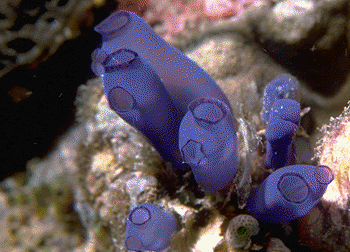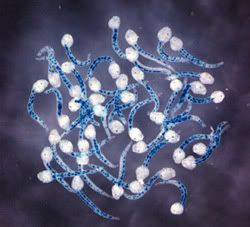Friday, April 01, 2005
A distant relative

Take a close look at the picture above this text. If you haven't been introduced to a sea squirt before you may be surprised to learn the blue blob depicted above is an animal. If that surprised you then you'll be flabbergasted to learn you are more closely related to that animal than 97% of all the species so far described on earth and very much more than 99% of the individual organisms here.
The animal in question is a sea squirt (or Urochordate or Tunicate) and it fits into the Phylum Chordata - the same one as you, me and all the vertebrates. On the face of it that seems a puzzling designation, the animal in the picture doesn't look much like respectable chordates like mammals or birds or fish, or even like visually similar invertebrates like the lancelet. That is, until you realise that what you're looking at is one half of a lifecycle split into two such disparate parts that it would do a butterfly proud. See, sea squirts start out life as larvae that look more or less like tadpoles:

Now that's a bit more like it. Sea squirt larvae contain notochords, nicely defined muscle segments and a post-anal tail . Just like you. When you where an embryo. The tiny tadpoles swim in the plankton before they metamorphose into their adult form. When the time comes they plant themselves head first onto some hard surface (rocks, reefs and piers being among their favourites) and proceed in dispensing with all the stuff they needed as a free swimming tadpole - including their tail and the head ganglion which served the role of a brain From here the sedentary, adult form develops. Essentially the adult sea squirt is a sack fill of sea water with two syphons - one "sucking" water in and the other "spitting" it out. These syphons ensure water flows over the pharyngeal basket which filters out food.
The sea squirts are also of interest to evolutionary biologists for a number of reasons. Firstly they may be able to tell us something about the evolution of the vertebrates. All the vertebrates share a common ancestor with the sea squirts, there are two main schools of thought as to how each lineage (vertebrates and sea squirts) got to where they are today:
- The common ancestor shared by sea squirts and other chordates was something like a sea squirt larva. After that point the sea squirts took up a sedentary "adult stage" while the vertebrates went on to form bones and limbs and all those great things.
- The common ancestor shared by sea squirts and other chordates was something like a modern sea squirt. At some stage a sea squirt larva became sexually mature before it took on a filter feeding "adult" stage. In this scheme the individual larva that reached sexual maturity as a 'tadpole' would be the progenitor of all vertebrates. The development of sexual maturity in an otherwise 'juvenile' stage is called neoteny and is epitomized by the Axolotl which is a sexually mature salamander larva.
Richard Dawkins reports in The Ancestor's Tale that molecular data tends to support the first of those schemes. Coincidentally, that scheme was proposed by that most prescient of biologists, Charles Darwin.
The other reason sea squirts interest evolutionary biologists is that, seen through our vertebrate minds, they seem to be bristling with potential for great things. Recent studies have shown that the sea squirts have genes containing all the motifs needed to get a blood clotting system going. Additionally they have some proteins that look a lot like Toll receptors - proteins associated with identifying pathogens in our system. In fact a glance through the genome of a sea squirt revels the seeds of nervous systems, eyesight, the immune system, and even the cardiovascular system.
Of course we shouldn't get carried away on thinking that the sea squirts are some sort of museum piece displaying the seeds from which we sprung. The sea squirts have kept what genes they have for a reason - living organism can be primitive but they can'e be ancestral. It's likely that genes we share with sea squirts have been co-opted into completely different roles and many that where in our common ancestor 500 million years ago have probably been lost. Still, not too bad for a blue blob huh?
7 Comments:
That fits in nicely. I would like to post it at Transistions. If you are interested you can:
1)Mail it to me and I will post it for you - in your name
2) I could give you access to the site and you can post it yourself
Whichever is better for you. Let me know. You are right a post on Tangled Bank might help draw contributors. I'll try to whip something up for you.
Meilleur prix dofus kamas stock de dofus kamas
Prix moins cher dofus kamas
vente dofus kamas sur www.virstock.com
Kamas par allopass sur dofus kamas
Dofus kamas par telephone sur dofus kamas
Dofus kamas audiotel sur dofus kamas
http://www.virstock.com/jsp/comments.jsp dofus kamas vente
http://www.virstock.com
I like your site and content. thanks for sharing the information keep updating, looking forward for more posts. Thanks
abcya












